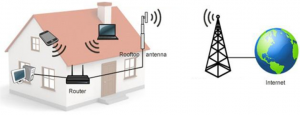Solving the Digital Divide with Fixed Wireless Access
If you’re reading this blog post at home or in the office, you have access to the internet. And if you’re in a city or suburb, you might even be lucky enough to be doing it over a high-speed broadband connection. Having high-speed broadband means you can easily do things like work from home, apply for jobs, shop, take online courses, do your banking, or even stream the latest Hollywood movies. But for millions of others, these activities remain out of reach. That’s because until now, high-speed connectivity required fiber to the home (FTTx), yet in some suburbs and sparsely populated areas, this simply hasn’t been a cost-effective option. Stringing fiber to every home and business is incredibly costly- especially in rural areas.
Over the years, insufficient or unequal internet connectivity has created the infamous ‘digital divide’ – a growing gap between the high-speed have and have-nots. According to the ITU, nearly half of the world’s population is still offline. And a significant percentage of those online have unreliable and poor connections.
Only 56% of Americans and 44% of Europeans (EU) had access to gigabit-speed service in 2020. Most of these connections are in urban areas – leaving many rural residents with poor internet speeds of less than 30 Mbps. And gigabit broadband connections in most developing countries are non-existent.
5G Fixed Wireless Access (FWA) is on track to help solve this issue because it allows cellular operators to deliver the same home or office internet speeds as fiber but at a fraction of the cost. What impact will this have on rural and underdeveloped communities? Let’s take a step back in history for a clue.
FWA – the Transcontinental Railroad of the 21st Century?
One hundred fifty-three years ago, in the U.S. town of Promontory, Utah, a railroad baron struck a golden spike into the ground to mark the Central Pacific and Union Pacific Railroads joining to form the transcontinental railroad. This changed America by allowing travelers and goods to get from one coast to another more quickly and cost-effectively. The cost of a coast-to-coast trip dropped 85%, and reduced travel time from several months in a horse-drawn carriage or stagecoach to two weeks in the comfort of a railcar. Hundreds of towns popped up along the rail lines like tributaries across the western frontier.
The transcontinental railroad connected rural communities at the turn of the century, and FWA could do the same today. Whether or not it will have the same transformational impact is yet to be seen – and could be years in the making. Still, with housing prices in popular urban areas skyrocketing and businesses shifting to a post-Covid ‘work from anywhere’ approach, many people are rethinking where they want to live. Often, a good internet connection is the only thing holding a family back from moving to a more affordable location. With 5G Fixed Wireless Access, that problem goes away.
The same is true for rural businesses, which could benefit greatly. Companies and branch offices require high-speed connectivity for electronic payment and eCommerce, cloud services, and software tools and applications. When high-speed broadband becomes available anywhere and everywhere, rural businesses, towns, and even farms can benefit as we shift to a world of connected things powered by 5G.
The Game-Changing Benefits of 5G FWA
5G FWA is a win-win. It allows cellular operators to maximize their spectrum investments and grow revenues in the fixed broadband space – a market that has been dominated by cable and fiber providers. And it will enable residential and business consumers in underserved markets to finally access the high-speed services they’ve been waiting for.
Key Cellular Operator Benefits of 5G FWA:
- Half the cost of deploying fiber
- Faster and more accessible – no trenching permits, poles, or digging required
- Gigabit speeds
- New market and revenue source
- Excellent use of excess wireless spectrum
- Low cost of entry – Existing towers and other network assets can be repurposed for FWA

Fig. 1: With FWA, the last mile goes wireless
Planning a 5G FWA Network Requires Specialized Tools
FWA uses radio waves to create a connection between a cell tower and an antenna located on the rooftop or facade of a customer’s home or business. From there, the signal goes to an indoor router where users can access it like Wi-Fi. (Fig. 1)
Planning a 5G FWA network is a step outside their comfort zone for most mobile operators. It’s a new way of delivering cellular service that requires specialized equipment and tools for proper planning and configuration.
TEOCO has upgraded its network planning suite of tools, called ASSET, to help operators plan and launch 5G fixed wireless access services more quickly and accurately. The toolset updates account for technology hurdles like 5G roof-mounted antennas and placement of small cells.
New Additions to TEOCO’s ASSET Suite:
- Create 5G FWA ‘what-if’ scenarios with 3-D Monte Carlo Simulations
- Accurately define multi-height FWA propagation models
- Plan for new FWA customer-premise equipment (CPE) terminals
- Analyse optimal CPE placement and track throughput
- View and analyse KPIs in map form for customer care insights
The world is finally at a place where bridging the digital divide is achievable, and TEOCO is here to help. Check out our full line of ASSET network planning solutions to help create your 5G FWA offering:
Contact us today to learn more.


